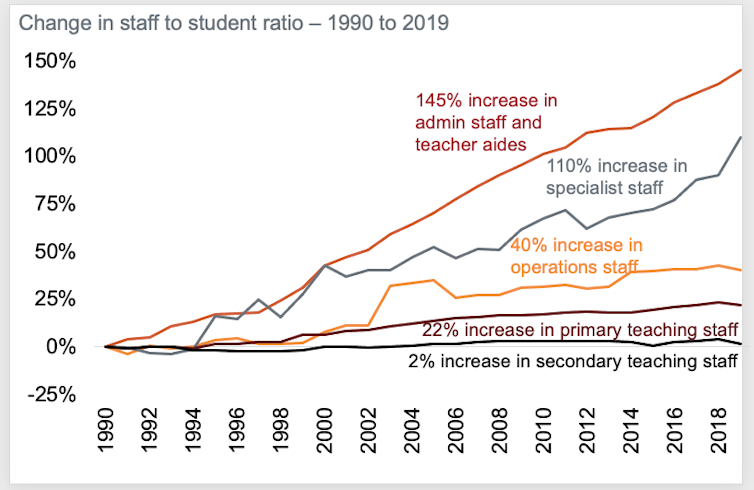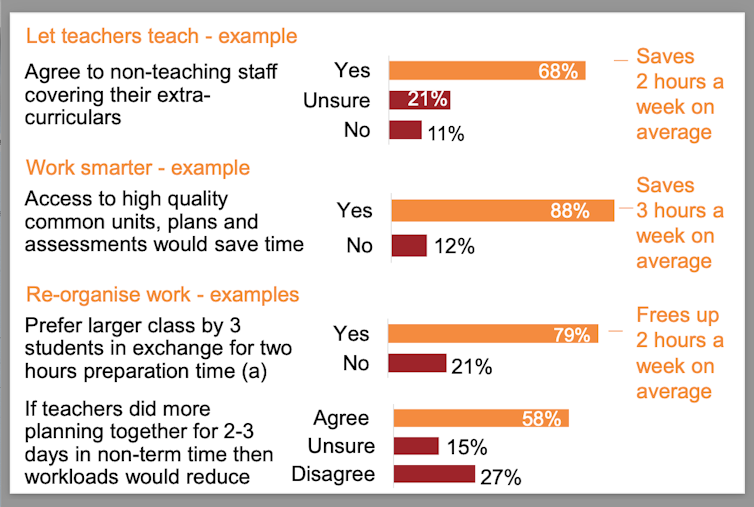Almost all teachers (92%) surveyed in our study today said they don’t have enough time to prepare effectively for classroom teaching – the core of their job.
The Grattan Institute surveyed 5,442 Australian teachers and school leaders across all states and territories, primary and secondary schools, and government and non-government schools. The survey focused on teachers’ timetables.
The teachers told us that they were too overwhelmed to do everything we asked of them. When teachers are not supported to do their job well, the quality of teaching suffers and students lose out.
Beyond preparing for effective teaching, 86% of teachers said they don’t have time to plan quality lessons.
Teachers say they don’t have time to properly prepare lessons
Grattan 2021 survey on teachers’ time, Author provided
Our results consistently show that many teachers feel overwhelmed by all they are expected to accomplish. A teacher told us:
[There is] not enough planning time to consider how we need to meet student needs.
Many teachers, especially in disadvantaged schools, said they received too little support to help struggling students.
And many teachers point to heavy requirements for writing reports, communicating with parents and supporting student well-being. A teacher said:
Administration time takes up most of the planning time – such as communication to parents, newsletters, postings, notes, permissions, phone calls and discussions with students about welfare issues. to be.
Teachers’ difficulty with workload is not due to a lack of effort – Australian teachers work hard. Census data shows that teachers in Australia work around 44 hours a week on average, far more than the 40 hours of general professionals.
Australian teacher working hours are also high by international standards. OECD data shows that Australian secondary school teachers work an average of 45 hours per week, compared to an international average of 40 hours.
Read more: ‘Exhausted beyond measure’: What teachers are saying about COVID-19 and education disruption
Our survey also revealed that school leaders are aware of the pressure on teachers’ time, but feel powerless to do much about it.
We cannot expect each of Australia’s 9,500 schools to solve these problems on their own. Governments must step up their efforts. Our report, Taking the Time to Teach Well, recommends that governments adopt three directions for reform.
1. Find ways for other school staff to take on non-teaching duties
Governments need to better match the work of teachers to their expertise. To do this, they need to find better ways to use the wider school workforce, including support staff and specialist staff, to help teachers focus on effective teaching.
A significant number of support staff and specialist staff have been added to schools over the past few decades. But governments have not figured out the best way to deploy them and use them well.

Grattan Analysis of ABS 2020, Schools, Australia, 2019 (and earlier years), Author provided
In our survey, about 68% of teachers agreed that support staff could cover their extracurricular activities. We estimate that this would free up two extra hours per week for teachers.
2. Help teachers reduce unnecessary tasks
Teachers consistently say they feel overburdened by administration. It is important to streamline administration where possible. But there are also important opportunities to improve the way teachers’ time is spent on core teaching tasks.
According to the OECD’s Teaching and Learning International Survey (TALIS), Australian teachers spend around a third of their time each week on basic teaching activities such as correcting student work, course preparation, teamwork and professional development.
This is four times the time spent on general administration (8%), so any improvement in basic teaching work could potentially free up large amounts of time.
Teachers don’t spend enough time teaching

OECD Grattan Analysis (2019), Author provided
Preparing for lessons is one of the main weekly activities of teachers. Yet more than half of teachers say it involves a lot of research and creating their own curriculum unit and lesson plans, assessments and classroom resources. This work takes a lot of time and is a significant obstacle for teachers who feel prepared for the classroom.
Nearly 90% of teachers agreed that having high-quality common resources for curriculum and lesson planning would help reduce their planning burden. This would free up three additional hours per week.
3. Rethinking the organization of teachers’ work
Political decisions and industrial agreements shape the fundamental ways in which teachers’ work is organized in schools. For example, they set the number of face-to-face teaching hours required each week, the number of students in each class, and expectations for teachers’ work during school vacations.
Governments should ensure that school leaders have the flexibility to redesign the work of teachers in ways that allow for more preparation time. For example, school leaders should have the flexibility to slightly increase class sizes (say from two to three students). Most teachers said they were in favor of a slight increase in class size in exchange for two extra hours of preparation each week.
Read more: Making better use of Australia’s best teachers will improve student outcomes: Here’s how
School leaders should also be given the opportunity to schedule more structured preparation and planning activities outside of school time. In our survey, 58% of teachers agreed that working together for two or three extra days before each term could reduce their workload during the term.
Teachers agreed to several reforms

Grattan 2021 survey on teachers’ time, Author provided
And then
Our report calls on Australian governments to commit to a $60 million program to explore and pilot practical options, including those tested in our report, that create more time for excellent teaching. This investment would represent only a tiny fraction (less than 0.1%) of the 65 billion dollars that Australian governments spend each year on schools. It is a small price to pay to improve the functioning of our schools and lighten the workload of teachers.
Ensuring that teachers have enough time for excellent teaching should be a national imperative.

